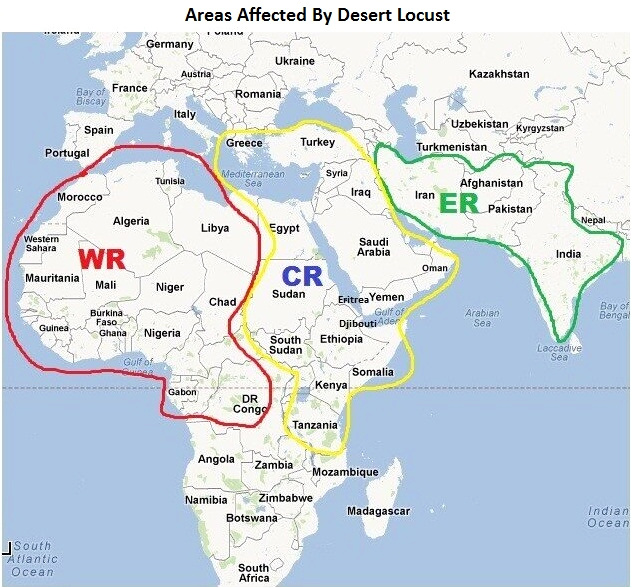Climate Change & Locust Infestations | 12 Nov 2021
Why in News
Infestation of desert locusts, which has plagued a vast swathe from eastern Africa to India in recent years, has been closely linked to climate change.
- In this context, the Global Landscapes Forum Climate Hybrid Conference has proposed that plans to mitigate climate change must include action against pests and diseases.
- The conference was recently held alongside the 26th Conference of Parties (CoP26) to the United Nations Framework Convention on Climate Change.
Global Landscapes Forum
- The Global Landscapes Forum (GLF) is the world’s largest knowledge-led platform on integrated land use, dedicated to achieving the Sustainable Development Goals and Paris Climate Agreement.
- It is led by the Center for International Forestry Research (CIFOR), in collaboration with its co-founders UNEP and the World Bank and Charter Members.
Key Points
- Locust Attack and its Impact:
- About: The desert locust (Schistocerca gregaria) is a short-horned grasshopper.
- Harmless when solitary, locusts undergo a behavioural change when their population builds up rapidly.
- They enter the ‘gregarious phase’ by forming huge swarms that can travel up to 150 km per day, eating up every bit of greenery on their way.
- Impact: Locust infestations can harm livelihoods and be a threat to regional investments in ensuring food security.
- According to the World Bank: In East Africa and Yemen alone, damages and losses in 2020 due to locusts could amount to as much as $8.5 billion.
- According to the World Food Program: The long-term response and recovery costs could top $1billion if swarm growth is not controlled.
- About: The desert locust (Schistocerca gregaria) is a short-horned grasshopper.
- Locust Breeding and Linkage With Climate Change:
- Affected Area: Locusts have been a bane especially to farmers in several countries, including India, Pakistan and Iran.
- Effect of Climate Change: Change in cyclonic patterns over the Arabian Sea is behind the locust invasions in east Africa, west and south Asia, in 2020.
- Unusual rainfall in Iran helped in their breeding.
- Locusts are known to be passive flyers and generally follow the wind.
- Their movement has been aided by westerly winds, which were further strengthened by the low-pressure area created by Cyclone Amphan (2019) in the Bay of Bengal.
- Pesticide is Not the Appropriate Solution:
- It said that heavy use of a broad-spectrum pesticide may slow down the desert locust invasion but they also exert significant external costs on the environment and human health.
- They are a threat to pollinators and wildlife.
- A broad-spectrum pesticide is a powerful pesticide that targets entire groups or species of organisms that are commonly harmful to plants.
- According to the Food and Agriculture Organization (FAO), by March 2021, 1.8 million litres of pesticides were used to control locusts in East Africa. This may increase to over two million litres by the end of 2021.
- Organophosphate pesticides such as Malathion and Chlorpyrifos, for instance, are highly toxic to humans and animals.
- It said that heavy use of a broad-spectrum pesticide may slow down the desert locust invasion but they also exert significant external costs on the environment and human health.
Way Forward
- Early Warning System: Satellite and weather data, along with field observations, can be used for building powerful predictive models on breeding sites.
- True Cost Accounting: Counting the environmental and human costs through True Cost Accounting.
- True Cost Accounting is a new type of bookkeeping that does not just look at the usual financial values within a company, but also calculates the impacts on natural and social capital.
- Developing an Efficient Governance Model: Governing the locusts crisis may also provide useful lessons for the agri-food system.
- There is a need to raise awareness amongst farmers and local communities as well as involve them in decision making.
- Mobilising Funds for Research: It is important to fund research on the biopesticide sector which remains extremely underfunded.
- The organisations responsible for preventing locust attacks face tremendous financial hurdles.
- In February 2020, $138 million was required by FAO to combat locusts outbreaks in East Africa. The organisation received only $33 million from donors.

